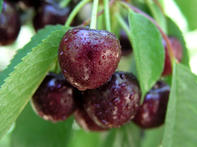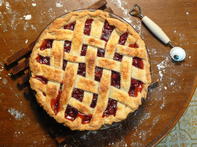These tiny sweet fruit ranging from yellow, red to purple-black are packed with nutrients and antioxidants, and contain a wealth of health benefits.

In South Africa, only sweet cherries, (Prunus avium), are produced, but tart or sour cherries, Prunus cerasus, used in baking and confectionery, are produced in countries such as Russia, the USA and Ukraine. The biggest production of sweet cherries came from Turkey for decades, but recently Chile became the biggest grower of sweet cherries in the world.
In South Africa, more than half the production of the 1 000 plus tonnes are sold as fresh eating fruit, in local retailers and markets, while about 26% is exported. Another 8% is processed.
Cherry Products

Apart from fresh sweet cherries available as Grade 1 or Grade 2 standard and packed in plastic punnets or into 5 kg cartons, cherries are also used to make cherry liqueurs and wines.
Other cherry products such as cherry sauces, jams, canned and glazed cherries are also produced in South Africa. Dried, powdered, freeze-dried and powdered dry cherries in capsules are also available. But cherry concentrate (for juice etc.) is imported.
Glazed cherries are produced in Ficksburg in the Free State Province in a simple but time-consuming process. Traditionally yellow cherries are used, picked just before turning red. If it starts turning red, it has to be bleached or blemishes will appear when glazed. Cherries are bleached in a metabisulphite solution for six weeks, hand-sorted, size-graded and de-stoned. The cherries are boiled for five days at 90°C and simmered at 50°C for two weeks. After the cook-out process, sugars and colourants are added. Before packing, glazed cherries are passed over a light table to check if all pips are removed. Glazed cherries are especially popular for baking around at Easter and Christmas.
The processing of yellow cherries can be divided into three categories: glazed cherries, Maraschino and non-bleeding cherries for canned mixed fruit. Only about 10% of processed cherries are from South Africa; the rest are imported from Italy.
What are Maraschino Cherries?

Maraschino cherries are not a variety of cherry but a bright-red coloured and processed cherry, often used in cocktails and desserts, such as ice creams.
The original maraschino cherries originated from the ‘marasca’, a small sour, black cherry that grew wild on the coast of Croatia. It was preserved by soaking it in a liqueur called ‘Marascino’. Commercially produced Maraschino cherries are not preserved with alcohol, but rather in a sugar solution, to which the addition of calcium keeps the cherries firm.
Benefits of Cherries
Cherries are a nutrient-dense food, low in kilojoules but high in fibre, polyphenols, carotenoids, vitamin C and potassium. Polyphenols, carotenoids and vitamins E and C contribute to the antioxidant and anti-inflammatory properties of cherries. Results from studies found that eating cherries may reduce the risk of inflammatory diseases including arthritis, cardiovascular disease and cancer. In addition, studies have found evidence that cherry consumption may promote healthy glucose regulation and may reduce the incidence or severity of arthritis.
Sweet cherries are high in antioxidants and even more so for tart (sour) cherries, which have the same natural sugar content as sweet cherries. Tart cherries contain more sour and bitter-tasting phytochemicals and are higher in antioxidant levels.
Apart from antioxidants, cherries are the only natural source of melatonin, a hormone which regulates the body's sleep-wake cycles.
Please note:
Information is for educational and informational purposes only and may not be construed as medical advice. The information is not intended to replace medical advice or treatment offered by healthcare professionals.
By Marinda Louw